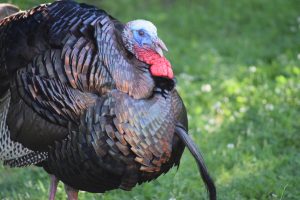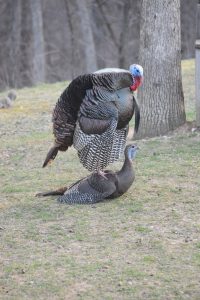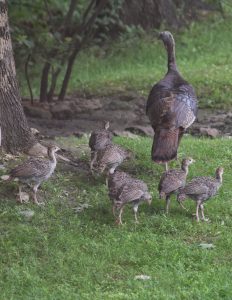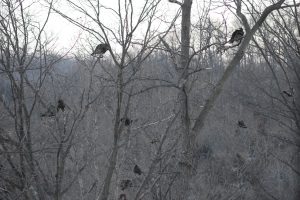Let’s Talk Turkey
‘Tis the season for eating turkey. According to the National Turkey Federation, 88% of the Americans surveyed eat turkey on Thanksgiving. That translates to 46 million turkeys consumed on Thanksgiving while another 22 million provide the main course at Christmas. These birds are mostly commercially grown turkeys bred and raised for the sole purpose of becoming our holiday meal. However, let us focus on the wild turkey.

The wild turkey is native to northern Mexico and the eastern United States. It has been said that Benjamin Franklin would have preferred the wild turkey to be our national symbol rather than the Bald Eagle. While this may or may not be true, in a letter to his daughter he called the Bald Eagle “a Bird of bad moral Character,” adding that he is “too lazy to fish for himself” and often steals food from hawks who have worked hard to catch their prey.
Founding Father Franklin further states, “the Turkey is in Comparison a much more respectable Bird, and withal a true original Native of America… He is besides, though a little vain & silly, a Bird of Courage, and would not hesitate to attack a Grenadier of the British Guards who should presume to invade his Farm Yard with a red Coat on.”

Habitat loss and over hunting eliminated the wild turkey from Illinois by 1910. The Illinois Department of Natural Resources successfully reintroduced them between 1959 and 1967 by obtaining wild-trapped turkeys from Mississippi, Arkansas and West Virginia and releasing them in southern Illinois. The reintroduced wild turkeys successfully established breeding populations, producing enough offspring that a trap-and-transfer program could be established. Today, the wild turkey is a resident of every county in Illinois.
Wild turkeys are large birds. The average adult male, called a gobbler or tom, stands up to 3½ feet tall and weighs up to 24 pounds. A young male, usually a one-year-old bird, is called a jake. Females, called hens, are typically 2½ to 3 feet tall and weigh up to 12 pounds. Both sexes have dark, iridescent feathers that display shades of bronze, red, purple, blue and green. However, hens have an overall lighter appearance because their breast feathers are tipped with brown, while those of a tom are tipped with black.

Besides being larger and darker, toms can generally be distinguished from hens by their leg spurs, beards, wattles (folds of skin below the beak), caruncles (wart-like growths on the neck) and snood (fleshy appendage above the beak). The wattles and caruncles of a tom can change color according to the turkey’s physical and mental health—when a male turkey is trying to attract a mate, they turn bright red. If the turkey is scared, the appendages take on a blue tint. And if the turkey is ailing, they become very pale.
Turkey beards grow from the chest of gobblers and are not made of hair, rather modified feathers or tufts of filaments. According to the National Wild Turkey Federation, the function of the wild turkey beard is not well understood, but it is suspected to play a role in male selection by the female. A longer beard signifies an older, healthier male and thus a superior mate.
Hens build their nests on the ground in shallow depressions that they scratch out in grasses or leaves, often against the base of woody vegetation. Wild turkeys lay an average of 10 to 12 eggs, approximately one per day until the hen has a full clutch. Incubation is done by the hen only and lasts for about 28 days. Young turkeys are called poults and are cared for only by the hen. Poults are ready to leave the nest within 24 hours of hatching but are unable to fly until they are 10 to 12 days old.

Now, for a few turkey facts:
- Wild turkeys can fly, reportedly up to 55 miles per hour.
- Turkeys can swim, although not often, by tucking their wings in, spreading their tails and kicking.
- Turkey poop can tell you a lot. If the droppings are shaped like a “J,” they were left by a male. Females leave spiral shaped droppings.
- Wild turkeys can see better than humans—having vision three times greater than 20/20.
- Not all turkeys gobble. Males gobble to communicate with their lady friends up to a mile away. Females make a clicking sound instead.
- A group of turkeys can be called a flock or a rafter.
- Turkeys sleep in trees. As the sun goes down, the turkeys go up—into the trees. They start by flying onto a low branch, then clumsily hop their way upward, branch by branch, until they reach a safe height, away from predators.
CLIFFTOP, a local nonprofit organization, is focused on preserving and protecting area blufflands.
A version of this article appeared in the December 6, 2019 edition of the Monroe County Independent.
©2019 all content rights reserved Clifftop NFP.
Comments are currently closed.
